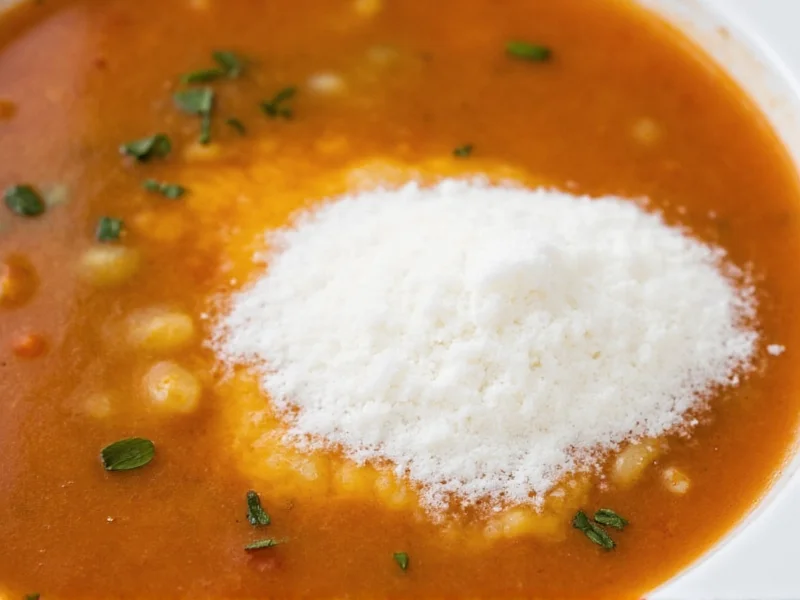Getting the perfect consistency for your soup can make or break your culinary creation. When using cornstarch as a thickener, precision matters—too little won't achieve the desired texture, while too much creates an unappetizing gloopy mess. This guide provides professional kitchen insights for perfectly thickened soups every time.
Understanding Cornstarch Thickening Ratios
Cornstarch is a powerful thickener, approximately twice as effective as flour. The magic happens when cornstarch granules absorb liquid and swell at temperatures above 203°F (95°C), creating that velvety texture professional chefs prize. Unlike flour, cornstarch produces a clear, glossy finish ideal for delicate broths and creamy soups.
| Soup Volume | Cornstarch Needed | Cold Liquid for Slurry | Final Consistency |
|---|---|---|---|
| 2 cups | 2 tablespoons | 2 tablespoons | Medium |
| 4 cups | 4 tablespoons (1/4 cup) | 4 tablespoons | Medium |
| 6 cups | 6 tablespoons (1/3 cup) | 6 tablespoons | Medium |
| 8 cups | 8 tablespoons (1/2 cup) | 8 tablespoons | Medium |
Step-by-Step Thickening Process
Follow these professional kitchen techniques for lump-free results:
- Prepare your slurry: Whisk cornstarch with an equal amount of cold liquid (water, broth, or milk) until completely smooth. Never add dry cornstarch directly to hot soup.
- Temperature matters: Ensure your soup is at a gentle simmer (not boiling vigorously) before adding the slurry.
- Slow incorporation: Gradually pour the slurry into the soup while whisking constantly in one direction.
- Wait for transformation: Allow 60-90 seconds for thickening to occur after adding the slurry—don't add more too quickly.
- Final adjustment: If needed, prepare additional slurry in small batches rather than dumping in extra cornstarch.
Avoiding Common Cornstarch Mistakes
Even experienced cooks encounter issues with cornstarch thickening. Here's how to prevent and fix the most frequent problems:
Lump Prevention Strategies
The cardinal rule: always mix cornstarch with cold liquid first. If lumps form despite your precautions, immediately remove the soup from heat and blend with an immersion blender. For severe cases, strain through a fine-mesh sieve while the soup is still warm.
Over-Thickening Recovery
Accidentally made your soup too thick? Gradually whisk in additional warm broth or water, 1/4 cup at a time, until reaching your desired consistency. Remember that soups continue thickening slightly as they cool.
Timing Considerations
Add cornstarch thickeners during the final 5-10 minutes of cooking. Extended boiling breaks down cornstarch's thickening power, while adding it too early can result in a thin, watery soup by serving time.
Special Considerations for Different Soups
Certain soup varieties require technique adjustments when using cornstarch:
- Cream-based soups: Use slightly less cornstarch (reduce by 25%) as dairy contributes additional thickness
- Acidic soups (tomato, lemon-based): Add cornstarch slurry off-heat, as acids can weaken thickening power
- Gluten-free requirements: Cornstarch provides superior clarity compared to alternative thickeners like arrowroot
- Freezable soups: Avoid cornstarch if planning to freeze, as it breaks down during thawing—opt for flour or instant mashed potatoes instead
When Cornstarch Isn't Available: Smart Substitutes
Ran out of cornstarch? These alternatives work in a pinch, though each affects flavor and texture differently:
- All-purpose flour: Use double the amount of cornstarch required (2 tbsp per cup of liquid), but expect a slightly cloudy appearance
- Arrowroot: Substitute at 1:1 ratio with cornstarch, ideal for acidic liquids but creates a more delicate gel
- Potato starch: Use same ratio as cornstarch, but avoid boiling as it breaks down quickly
- Instant mashed potato flakes: Add 1-2 tbsp per cup of soup for subtle thickening without altering flavor
Professional Chef Tips for Perfect Soup Texture
Seasoned culinary professionals rely on these advanced techniques:
- The finger test: Dip a clean finger in the soup—properly thickened soup should lightly coat your finger without running off immediately
- Plate test: Spoon some soup on a white plate; it should leave a trail when tilted rather than flowing freely
- Temperature check: Use an instant-read thermometer to ensure your soup reaches 203°F (95°C), the activation point for cornstarch
- Resting period: Allow thickened soups to rest for 5-10 minutes before serving, as the texture continues to develop off-heat
Frequently Asked Questions
Can I use cornstarch to thicken cold soups like vichyssoise?
Cornstarch requires heat to activate its thickening properties. For cold soups, prepare a slurry separately by cooking it until thickened, then cool completely before incorporating into your chilled soup base. Alternatively, consider using guar gum or xanthan gum which work in cold applications.
Why does my cornstarch-thickened soup become thin after refrigeration?
Cornstarch-thickened soups can break down when reheated after refrigeration due to prolonged exposure to moisture. To prevent this, slightly under-thicken your soup initially (use 25% less cornstarch than recommended), as soups naturally thicken when chilled. When reheating, add a small amount of fresh slurry if needed.
How much cornstarch should I use for a creamy tomato soup?
For acidic tomato-based soups, use 1.5 tablespoons of cornstarch per cup of liquid instead of the standard 1 tablespoon. The acidity weakens cornstarch's thickening power, requiring a slightly higher ratio. Always mix the slurry with cold liquid first, then temper it by adding a small amount of hot soup before incorporating into the main batch.
Can I substitute cornstarch for flour in soup recipes?
Yes, but use half the amount of cornstarch compared to flour since it's twice as powerful. For example, if a recipe calls for 4 tablespoons of flour, use 2 tablespoons of cornstarch. Remember that cornstarch creates a clearer, glossier finish than flour's matte appearance, and doesn't require cooking out a raw flour taste.
What's the difference between using cornstarch and arrowroot for thickening soup?
Cornstarch produces a more stable, glossy finish that works well with dairy, while arrowroot creates a clearer gel that's better for acidic liquids but breaks down with prolonged cooking. Cornstarch requires higher temperatures (203°F/95°C) to activate, whereas arrowroot thickens at lower temperatures. Arrowroot also has a slightly more neutral flavor but can become slimy if overused.











 浙公网安备
33010002000092号
浙公网安备
33010002000092号 浙B2-20120091-4
浙B2-20120091-4